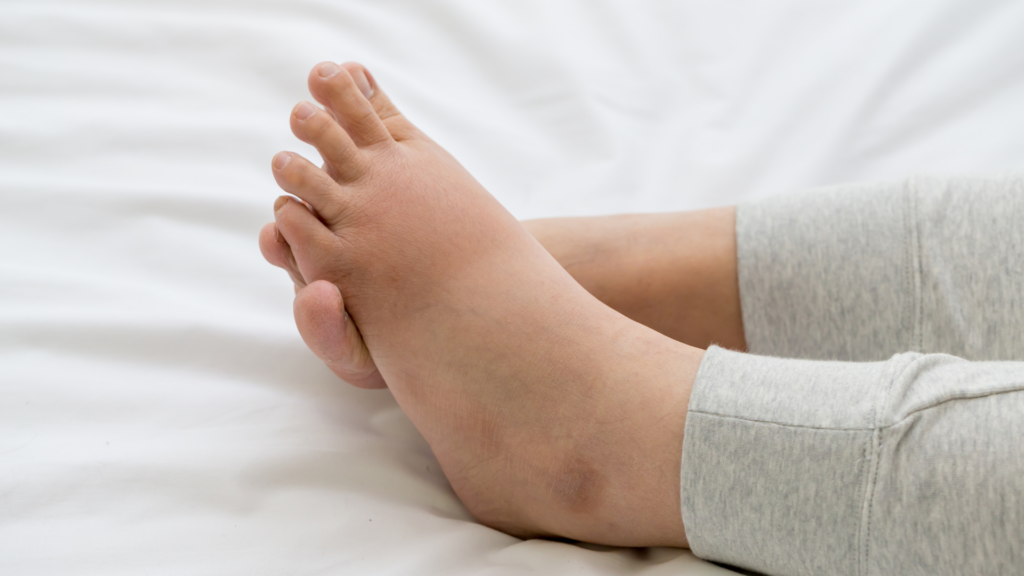Foot swelling, or edema, is a condition that affects many individuals and can be caused by various factors such as surgery, medical conditions, and prolonged standing. Swollen feet can be uncomfortable and, if left untreated, may lead to serious complications, including circulatory problems and mobility restrictions. Fortunately, several effective treatments, such as support stockings for foot swelling, lifestyle adjustments, and post-surgical care, can help manage this condition and improve overall foot health. For more information on compression stockings and their benefits, you can refer to this WebMD article.
At Fall Creek Foot & Ankle, we specialize in diagnosing and treating foot swelling to prevent complications and improve mobility. This guide explores the causes of foot swelling and the best strategies to prevent and manage it effectively.
What Causes Foot Swelling?
Foot swelling can be caused by multiple conditions, ranging from temporary discomfort to chronic medical issues. Understanding the underlying causes can help determine the best treatment approach.
- Support Stockings for Foot Swelling – Weak veins or venous insufficiency can lead to improper blood circulation, causing fluid accumulation and foot swelling. Compression stockings improve circulation, reducing swelling and providing relief.
- Foot Swelling After Knee Surgery – Post-surgical inflammation is common and can persist for weeks or months. Swelling occurs as part of the body’s healing response but should be monitored to avoid complications such as blood clots or infections.
- Diabetic Foot Swelling – Diabetes can cause fluid retention due to poor circulation, nerve damage, or kidney dysfunction, making swelling a common and concerning symptom for diabetic patients.
- Prolonged Standing or Sitting – Lack of movement can lead to poor circulation, causing the feet to retain excess fluid.
- Heart, Kidney, or Liver Disease – These conditions may result in systemic fluid retention, often leading to swelling in the feet and ankles.
How Support Stockings for Foot Swelling Can Help
Compression stockings, also known as support stockings, are one of the most effective treatments for foot swelling. These specially designed garments apply pressure to the legs and feet to help improve circulation and prevent fluid buildup.
Benefits of Support Stockings for Foot Swelling:
- Reduce swelling and discomfort
- Improve venous blood flow and circulation
- Prevent blood clots in post-surgical patients
- Support recovery after injuries or surgery
- Minimize the risk of diabetic complications
How to Choose the Right Compression Socks:
Selecting the right support stockings for foot swelling depends on factors such as compression level, material, and individual health conditions.
- Compression Level – Light (8-15 mmHg) for mild swelling, moderate (15-20 mmHg) for daily use, and firm (30-40 mmHg) for severe swelling.
- Fit and Size – Proper fitting ensures effectiveness and comfort. Socks that are too tight can restrict circulation, while loose socks won’t provide adequate support.
- Breathable Material – Moisture-wicking fabrics help keep feet dry and prevent infections, especially for diabetic patients.
To learn more about how support stockings for foot swelling can improve circulation and foot health, visit our Compression Therapy Page.
Managing Foot Swelling After Knee Surgery
Swelling after knee surgery is a common occurrence and can last for several weeks. This post-surgical inflammation is a natural part of the healing process but must be managed properly to prevent complications.
How to Reduce Foot Swelling After Knee Surgery:
- Elevate the Legs – Keeping feet above heart level helps fluid drain from the lower extremities.
- Use Support Stockings – Compression stockings provide support and reduce post-surgical swelling.
- Ice Therapy – Applying ice packs can minimize inflammation and promote faster healing.
- Hydration and Diet – Proper hydration helps regulate fluid retention, and a low-sodium diet can prevent excessive swelling.
- Physical Therapy and Movement – Gentle movement promotes circulation and prevents blood clots.
If post-surgical swelling persists or worsens, consult a podiatrist at Fall Creek Foot & Ankle for a professional assessment.
Diabetic Foot Swelling: Risks and Prevention
Diabetic patients are particularly vulnerable to foot swelling due to poor circulation, nerve damage (neuropathy), and kidney-related fluid retention. If left unmanaged, swelling can lead to more serious complications such as foot ulcers, infections, and amputations.
How to Manage and Prevent Diabetic Foot Swelling:
- Daily Foot Inspections – Check for swelling, redness, sores, or signs of infection.
- Wear Support Stockings – Compression socks designed for diabetics can improve circulation without restricting blood flow.
- Footwear Matters – Choose shoes with proper arch support and cushioning to reduce pressure on the feet.
- Blood Sugar Control – Maintaining stable glucose levels can prevent swelling and other diabetic complications.
- Stay Active – Regular physical activity improves circulation and reduces fluid retention.
For specialized diabetic foot care, schedule an appointment with our specialists at Fall Creek Foot & Ankle.
When to See a Podiatrist for Foot Swelling
While mild swelling can often be managed at home, chronic or severe swelling may require medical attention. Seek professional care if:
- Swelling does not improve with rest or compression therapy.
- You experience severe pain, numbness, or tingling.
- The swelling is accompanied by skin discoloration or open sores.
- You have a history of diabetes, circulation disorders, or recent surgery.
Take Control of Your Foot Health Today
Persistent foot swelling can significantly impact daily life and mobility, but with the right treatment and preventative measures, relief is possible. At Fall Creek Foot & Ankle, we provide comprehensive care for foot swelling, post-surgical recovery, and diabetic foot health.
Take proactive steps to improve your foot health today with expert guidance and personalized treatment.

